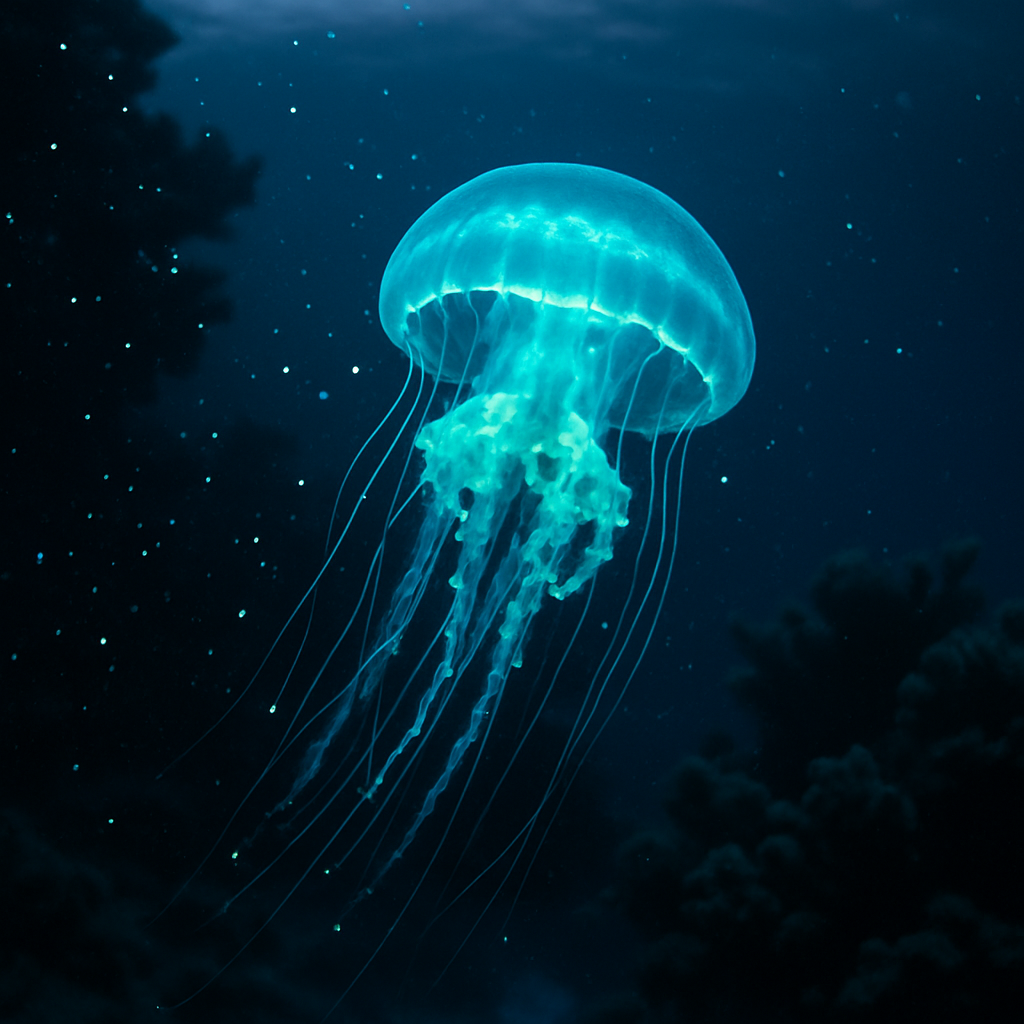The Fascinating World of Bioluminescent Creatures

Imagine walking along a moonless beach at night when suddenly, the waves begin to glow an ethereal blue with each crash against the shore. Or picture yourself deep in a cave where thousands of tiny lights twinkle like stars on the ceiling. These aren’t scenes from a fantasy movie they’re real phenomena created by bioluminescent organisms.
Bioluminescence the production of light by living creatures ranks among nature’s most magical displays. From the depths of the ocean to forest floors, numerous species have developed the ability to create their own light through chemical reactions. This biological light show isn’t just beautiful; it serves crucial functions for survival and represents one of evolution’s most fascinating adaptations.
Light Makers of the Deep
The ocean houses approximately 80% of all bioluminescent organisms on Earth. This makes perfect sense when you consider that sunlight penetrates only the top 200 meters of water in the clearest conditions. Below that lies a vast darkness where the ability to produce light offers significant advantages.
Anglerfish might be the poster child for deep-sea bioluminescence and nightmare fuel for anyone who’s seen Finding Nemo. These fish sport a modified dorsal fin that dangles in front of their mouths like a fishing rod (hence the name) with a glowing lure at the end. The light comes from symbiotic bacteria living inside the lure. When smaller fish approach this tempting light, they quickly become dinner.
“The first time I saw footage of an anglerfish, I literally spilled coffee all over my desk,” says marine biologist Dr. Edith Widder. “These creatures look like they were designed by a committee of horror movie directors.”
But not all deep-sea bioluminescence is about luring prey. Take the vampire squid, which doesn’t actually suck blood despite its ominous name. When threatened, it can activate light-producing organs called photophores all over its body in a dazzling display scientists call a “light show.” This confuses predators long enough for the squid to escape.
Then there’s the cookiecutter shark, which uses bioluminescence in perhaps the most devious way. Its underside glows except for a dark collar around its neck. From below, this makes the shark appear as a small fish to larger predators swimming above. When the larger fish approaches what it thinks is prey, the cookiecutter takes a cookie-shaped bite out of it and swims away.
Some deep-sea creatures use bioluminescence for counterillumination a form of camouflage. Hatchetfish have light-producing organs on their bellies that match the faint sunlight filtering down from above, making them nearly invisible to predators looking up from below.
From Oceans to Land
While marine environments host the majority of bioluminescent species, land-dwelling light-makers create equally spectacular displays.
Fireflies (which are actually beetles, not flies) might be the most familiar terrestrial bioluminescent creatures. On summer evenings across many parts of the world, these insects create magical light patterns as part of their mating rituals. Male fireflies flash specific patterns while flying, and females respond with their own flashes from perches on plants. Each firefly species has its own unique flash pattern essentially a light-based language of love.
I spent many childhood summers catching fireflies in jars (and releasing them before bedtime, of course). What I didn’t know then was that I was watching an elaborate courtship dance that had evolved over millions of years.
Some firefly species have evolved remarkable behaviors around their light signals. Females of the genus Photuris can mimic the flash patterns of other firefly species to lure males close enough to catch and eat them a strategy scientists call “femme fatale.”
Less commonly known are bioluminescent fungi, sometimes called “fox fire” or “fairy fire.” Walking through certain forests at night, you might spot a ghostly green-blue glow emanating from rotting logs. This comes from fungi like Mycena chlorophos or species of Armillaria. Scientists aren’t entirely sure why these fungi glow, but one theory suggests the light attracts insects that help spread fungal spores.
Perhaps the most unexpected terrestrial bioluminescent creatures are certain millipedes and earthworms. The millipede Motyxia produces a blue-green glow as a warning signal to predators, advertising its toxic cyanide defense. Meanwhile, some earthworm species in the southern hemisphere emit a mysterious blue light when disturbed.
The Chemistry Behind the Glow
How exactly do these organisms create light? The process involves a chemical reaction between a compound called luciferin and an enzyme called luciferase (from the Latin “lucifer,” meaning “light-bringer”). When these chemicals mix with oxygen, the reaction produces light with very little heat what scientists call “cold light.”
Different species have evolved their own versions of luciferins and luciferases, which is why bioluminescent organisms produce different colors of light, from the blue glow of most marine creatures to the yellow-green flashes of fireflies.
What makes this system remarkable is its efficiency. A standard incandescent light bulb converts only about 10% of its energy into light (the rest becomes heat). Bioluminescent reactions, by comparison, can convert up to 98% of energy into light.
“If we could replicate that efficiency in our lighting systems,” notes biochemist Dr. Jennifer Marshall, “we’d solve a significant portion of our energy problems overnight.”
The specific colors produced by bioluminescent organisms aren’t random. Most marine bioluminescence appears blue or green because these wavelengths travel farthest in water. Fireflies, with no such constraint, produce light ranging from green to yellow and even red, depending on the species.
Some jellyfish produce both green and red light, using the red as a kind of underwater flashlight to spot prey that can’t see red wavelengths. The crystal jellyfish (Aequorea victoria) became famous in scientific circles when researchers isolated the gene for its green fluorescent protein (GFP). This protein revolutionized biological research by allowing scientists to track specific proteins within cells an achievement recognized with the 2008 Nobel Prize in Chemistry.
Applications Beyond Nature
The practical applications of bioluminescence extend far beyond basic research. Medical imaging techniques use luciferase genes to track the spread of cancer cells or the progression of infections. Environmental scientists deploy bioluminescent bacteria as biosensors to detect toxins in water samples.
Military researchers have studied bioluminescence for potential applications in covert operations. Some navies already monitor natural bioluminescence, which can reveal submarine movements when disturbed organisms light up in response.
Genetic engineers have created bioluminescent plants that glow faintly at night, potentially offering an alternative to electric lighting someday. Though current versions produce only dim light, researchers continue working to increase brightness.
Perhaps the most visible commercial application appears in novelty items like glow sticks, which mimic bioluminescence using similar chemical principles (though with different compounds).
Tourism centered around bioluminescent displays has grown popular in recent years. Kayaking through bioluminescent bays in Puerto Rico or swimming among glowing plankton in the Maldives gives people firsthand experience with this natural phenomenon. The sight of water lighting up with each paddle stroke or hand movement creates memories that last a lifetime.
The study of bioluminescence continues yielding new discoveries. As recently as 2020, researchers identified previously unknown bioluminescent species in deep-sea environments. With only about 20% of the ocean explored, countless light-producing organisms likely remain undiscovered.
Bioluminescence reminds us that nature often surpasses human innovation. While we struggled for centuries to create efficient light sources, countless species evolved this ability millions of years ago. By studying these natural light-makers, we gain insights that might help solve modern challenges in medicine, environmental monitoring, and energy efficiency.
Next time you see a firefly’s flash or are lucky enough to witness waves glowing blue at night, take a moment to appreciate the complex biochemistry and evolutionary history behind that light. What appears magical to our eyes represents one of nature’s most sophisticated adaptations a perfect example of how evolution can produce solutions as beautiful as they are functional.


